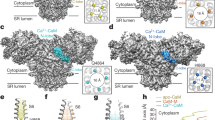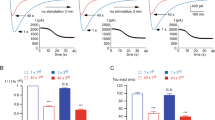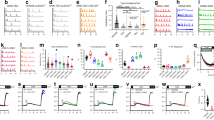Abstract
A dynamic positive feedback mechanism, known as ‘facilitation’, augments L-type calcium-ion currents (ICa) in response to increased intracellular Ca2+ concentrations. The Ca2+-binding protein calmodulin (CaM) has been implicated in facilitation, but the single-channel signature and the signalling events underlying Ca2+/CaM-dependent facilitation are unknown. Here we show that the Ca2+/CaM-dependent protein kinase II (CaMK) is necessary and possibly sufficient for ICa facilitation. CaMK induces a channel-gating mode that is characterized by frequent, long openings of L-type Ca2+ channels. We conclude that CaMK-mediated phosphorylation is an essential signalling event in triggering Ca2+/CaM-dependent ICa facilitation.
This is a preview of subscription content, access via your institution
Access options
Subscribe to this journal
Receive 12 print issues and online access
$209.00 per year
only $17.42 per issue
Buy this article
- Purchase on Springer Link
- Instant access to full article PDF
Prices may be subject to local taxes which are calculated during checkout




Similar content being viewed by others
References
Murphy, T. H., Worley, P. F. & Baraban, J. M. L-type voltage-sensitive calcium channels mediate synaptic activation of immediate early genes. Neuron 7, 625–635 (1991).
Artalejo, C. R., Adams, M. E. & Fox, A. P. Three types of Ca2+ channel trigger secretion with different efficacies in chromaffin cells. Nature 367, 72–76 (1994).
Tanabe, T., Beam, K. G., Powell, J. A. & Numa, S. Restoration of excitation-contraction coupling and slow calcium current in dysgenic muscle by dihydropyridine receptor complementary DNA. Nature 336, 134–139 (1988).
Hadley, R. W. & Lederer, W. J. Ca2+ and voltage inactivate Ca2+ channels in guinea-pig ventricular myocytes through independent mechanisms. J. Physiol. (Lond.) 257–268 (1991).
Marban, E. & Tsien, R. W. Enhancement of calcium current during digitalis inotropy in mammalian heart: positive feed-back regulation by intracellular calcium? J. Physiol. (Lond.) 329, 589–614 (1982).
McCarron, J. G. et al. Calcium-dependent enhancement of calcium current in smooth muscle by calmodulin-dependent protein kinase II. Nature 357, 74–77 (1992).
Xiao, R. P., Cheng, H., Lederer, W. J., Suzuki, T. & Lakatta, E. G. Dual regulation of Ca2+/calmodulin-dependent kinase II activity by membrane voltage and by calcium influx. Proc. Natl Acad. Sci.USA 91, 9659–9663 (1994).
Yuan, W. & Bers, D. M. Ca-dependent facilitation of cardiac Ca current is due to Ca-calmodulin-dependent protein kinase. Am. J. Physiol. 267, H982–H993 (1994).
Anderson, M. E., Braun, A. P. & Schulman, H. & Premack, B. A. Multifunctional Ca2+/calmodulin-dependent protein kinase mediates Ca2+-induced enhancement of the L-type Ca2+ current in rabbit ventricular myocytes. Circ. Res. 75 854–861 (1994).
Zuhlke, R. D., Pitt, G. S., Deisseroth, K., Tsien, R. W. & Reuter, H. Calmodulin supports both inactivation and facilitation of L-type calcium channels. Nature 399, 159–162 (1999).
Payne, M. E. et al. Calcium/calmodulin-dependent protein kinase II. Characterization of distinct calmodulin binding and inhibitory domains. J. Biol. Chem. 263, 7190–7195 (1988).
Braun, A. P. & Schulman, H. A non-selective cation current activated via the multifunctional Ca(2+)-calmodulin-dependent protein kinase in human epithelial cells. J. Physiol. (Lond.) 488, 37–55 (1995).
Sculptoreanu, A., Scheuer, T. & Catterall, W. A. Voltage-dependent potentiation of L-type Ca2+ channels due to phosphorylation by cAMP-dependent protein kinase. Nature 364, 240–243 (1993).
Lacerda, A. E., Rampe, D. & Brown, A. M. Effects of protein kinase C activators on cardiac Ca2+ channels. Nature 335, 249–251 (1988).
Odermatt, A., Kurzydlowski, K. & MacLennan, D. H. The vmax of the Ca2+-ATPase of cardiac sarcoplasmic reticulum (SERCA2a) is not altered by Ca2+/calmodulin-dependent phosphorylation or by interaction with phospholamban. J. Biol. Chem. 271, 14206–14213 (1996).
Hain, J., Nath, S., Mayrleitner, M., Fleischer, S. & Schindler, H. Phosphorylation modulates the function of the calcium release channel of sarcoplasmic reticulum from skeletal muscle. Biophys. J. 67, 1823–1833 (1994).
Wu, Y., MacMillan, L. B., McNeill, R. B., Colbran, R. J. & Anderson, M. E. CaM kinase augments cardiac L-type Ca2+ current: a cellular mechanism for long Q-T arrhythmias. Am. J. Physiol. 276, H2168–H2178 (1999).
Hamill, O. P., Marty, A., Neher, E., Sakmann, B. & Sigworth, F. J. Improved patch-clamp techniques for high-resolution current recording from cells and cell-free membrane patches. Pflugers Arch. 391, 85–100 (1981).
Chao, S. H., Suzuki, Y., Zysk, J. R. & Cheung, W. Y. Activation of calmodulin by various metal cations as a function of ionic radius. Mol. Pharmacol. 26, 75–82 (1984).
Hess, P., Lansman, J. P. & Tsien, R. W. Different modes of Ca channel gating behavior favoured by dihydropyridine Ca agonists and antagonists. Nature 311, 538–544 (1984).
Li, L., Satoh, H., Ginsburg, K. S. & Bers, D. M. The effect of Ca(2+)-calmodulin-dependent protein kinase II on cardiac excitation-contraction coupling in ferret ventricular myocytes. J. Physiol. (Lond.) 501, 17–31 (1997).
Anderson, M. E. et al. KN-93, an inhibitor of multifunctional Ca 2+/calmodulin dependent protein kinase, decreases early afterdepolarizations in rabbit heart. J. Pharmacol. Exp. Ther. 287, 996–1006 (1998).
Mazur, A., Roden, D. M. & Anderson, M. E. Systemic administration of calmodulin antagonist W-7 or protein kinase A inhibitor H-8 prevents Torsade de Pointes in rabbits. Circulation 100, 2437–2442 (1999).
Yue, D. T., Herzig, S. & Marban, E. Beta-adrenergic stimulation of calcium channels occurs by potentiation of high-activity gating modes. Proc. Natl Acad. Sci.USA 87, 753–757 (1990).
Lee, A. et al. Ca2+/calmodulin binds to and modulates P/Q-type calcium channels. Nature 399, 155–159 (1999).
Peterson, B. Z., DeMaria, C. D., Adelman, J. P. & Yue, D. T. Calmodulin is the Ca2+ sensor for Ca2+-dependent inactivation of L-type calcium channels. Neuron 22, 549–558 (1999).
Bers, D. M., Patton, C. W. & Nuccitelli, R. A practical guide to the preparation of Ca2+ buffers. Methods Cell Biol. 40, 3–29 (1994).
VanDongen, A. M. A new algorithm for idealizing single ion channel data containing multiple unknown conductance levels. Biophys. J. 70, 1303–1315 (1996).
Ishida, A. & Fujisawa, H. Stabilization of calmodulin-dependent protein kinase II through the autoinhibitory domain. J. Biol. Chem. 270, 2163–2170 (1995).
Glass, D. B., Cheng, H. C., Mende-Mueller, L., Reed, J. & Walsh, D. A. Primary structural determinants essential for potent inhibition of cAMP-dependent protein kinase by inhibitory peptides corresponding to the active portion of the heat-stable inhibitor protein. J. Biol. Chem. 264, 8802–8810 (1989).
House, C. & Kemp, B. E. Protein kinase C contains a pseudosubstrate prototope in its regulatory domain. Science 238, 1726–1728 (1987).
Gupta, R. C. & Kranias, E. G. Purification and characterization of a calcium-calmodulin-dependent phospholamban kinase from canine myocardium. Biochemistry 28, 5909–5916 (1989).
Sigworth, F. J. & Sine, S. M. Data transformations for improved display and fitting of single-channel dwell time histograms. Biophys. J. 52, 1047–1054 (1987).
Acknowledgements
This work was supported by grants from the NIH (grants NHLBI, HL03727 and HL62494 to M.E.A.) and the American Heart Association (to M.E.A. and R.J.C.). J.R.B. is an Established Investigator of the American Heart Association. We thank M. Bass for technical assistance, and D. Roden and A. George for helpful criticisms and suggestions.
Correspondence and requests for materials should be addressed to M.E.A.
Author information
Authors and Affiliations
Corresponding author
Rights and permissions
About this article
Cite this article
Dzhura, I., Wu, Y., Colbran, R. et al. Calmodulin kinase determines calcium-dependent facilitation of L-type calcium channels. Nat Cell Biol 2, 173–177 (2000). https://doi.org/10.1038/35004052
Received:
Revised:
Accepted:
Published:
Issue Date:
DOI: https://doi.org/10.1038/35004052
This article is cited by
-
Paradigm shift: new concepts for HCN4 function in cardiac pacemaking
Pflügers Archiv - European Journal of Physiology (2022)
-
Investigating and characterizing the binding activity of the immobilized calmodulin to calmodulin-dependent protein kinase I binding domain with atomic force microscopy
Chemistry Central Journal (2017)
-
Lead poisoning: acute exposure of the heart to lead ions promotes changes in cardiac function and Cav1.2 ion channels
Biophysical Reviews (2017)
-
Calmodulin kinase II inhibitor regulates calcium homeostasis changes caused by acute β-adrenergic receptor agonist stimulation in mouse ventricular myocytes
In Vitro Cellular & Developmental Biology - Animal (2016)
-
Retraction Note: Calmodulin kinase determines calcium-dependent facilitation of L-type calcium channels
Nature Cell Biology (2015)



